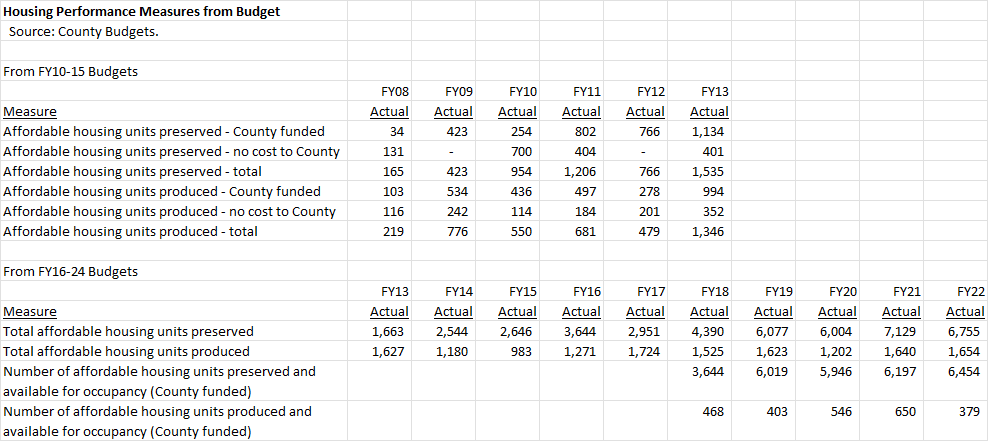By Adam Pagnucco.
Let’s review what we have learned so far. Part One introduced the Housing Initiative Fund (HIF), which is the county government’s primary vehicle for funding the preservation and construction of affordable housing. Part Two showed how the county has been directing more money into the HIF in recent years. Part Three showed how the county government’s operating expenditures for housing are similar to those of more than a decade ago in real dollars while the HIF’s fund balance has been rising. Now let’s try to measure our performance.
How much housing are we getting for the extra money we are investing? It turns out that that is a hard question to answer. The county’s Department of Housing and Community Affairs (DHCA) issues periodic reports on its activities with the most recent one applying to Fiscal Years 2020 and 2021. In terms of statistical measures, the report says this:
*****
Montgomery County’s Department of Housing and Community Affairs committed $58.8 million in Fiscal Year 2020 and $53.1 million in Fiscal Year 2021, along with policy tools, to reduce the housing cost burden of residents through a range of strategies that preserved and produced affordable housing and protected people who are most vulnerable. Overall, in both FY20 and FY21, the County supported approximately 6,300 affordable housing units through financing to establish long-term affordability, rental assistance to maintain affordability, support for home purchasing, and MPDUs (moderately priced dwelling units). Included in this total, the County supported preservation and production of approximately 1,000 more rent-regulated affordable housing units, each year…
In FY20, the County committed approximately $34.5 million in low- or no-interest loans from the Housing Initiative Fund (HIF) to preserve 329 units and produce 202 units of long-term affordable rental housing for individuals, families, seniors and persons with special needs. In FY21, the County committed approximately $68 million in HIF loans to preserve 221 units and produce 312 units of long-term affordable housing.
*****
There is also some discussion of money, plenty of discussion of housing tools and a few examples of DHCA projects. But I have not been able to find a long-term time series of units built and preserved each year along with their cost to the county.
There is some data available in the county’s operating budgets, but it has series breaks and its terms are not defined. The table below represents my best attempt to assemble the performance measures available from the budgets.

I have questions about this data from a statistical perspective. What do these terms mean and are they consistently applied over the years? It’s impossible to tell from the budget. Are we getting more housing for our money? It appears that more units are being preserved than 5-10 years ago, but who knows? Production may have dipped and rebounded but does not appear to have an upwards trend. Again, who knows?
I am not saying that the county is doing a bad job on housing. But I find these numbers as confusing as anything I have previously seen from county government.
The HIF badly needs an annual, standardized report showing its performance not just in dollars but also in units. There is a model for this: the county’s annual reports for its Economic Development Fund (EDF), which is its vehicle for distributing corporate welfare. The 2021 EDF report shows a variety of historical measures including estimates of jobs created and reserved through county incentives. It’s not perfect but it is far superior to the information available on the HIF’s performance.
Incidentally, I was eventually able to locate a report specific to the HIF rather than applying broadly to all of DHCA. It was produced for Fiscal Year 2002. Not 2022, but 2002.
Next: let’s learn some lessons.
